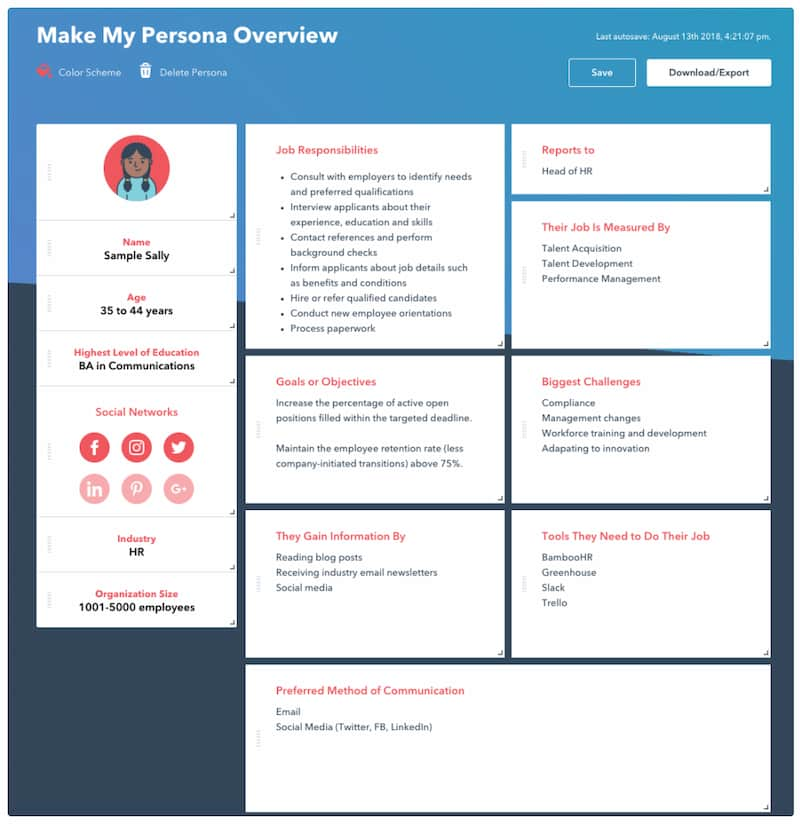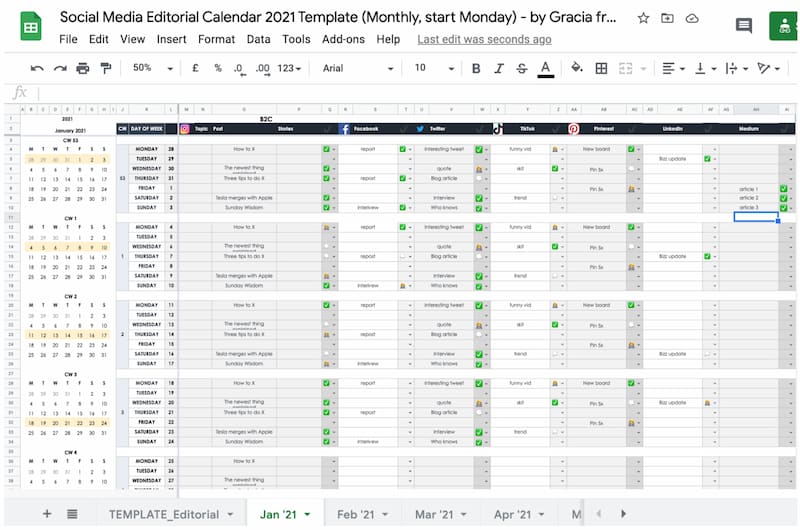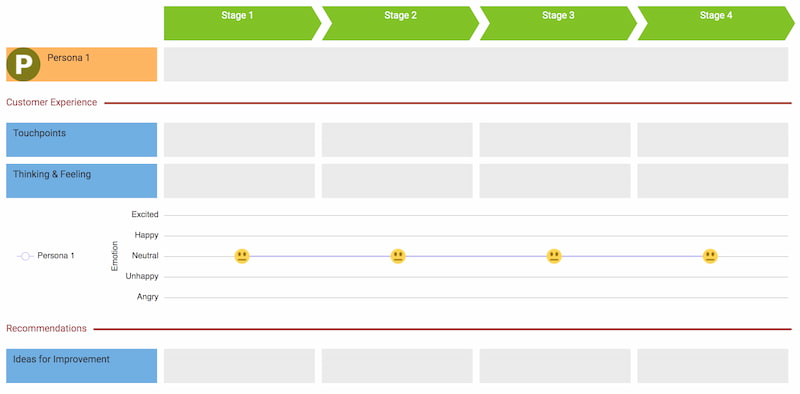Crush your content marketing goals with these time-saving tips, checklists, and templates
Take your content marketing efforts to the next level
Content marketing is one of the most effective ways to raise brand awareness. By publishing quality content, you can reach your target audience and build authority.
But there’s more to content marketing than publishing a blog post and calling it a day. For your efforts to be successful, you need a cohesive strategy that aligns your content with your core values and business objectives.
Putting together a content marketing plan isn’t exactly easy, though. The good news is you don’t have to start entirely from scratch.
In this article, we put together a comprehensive list of time-saving tips, checklists, and templates that you can use to conquer your content marketing goals.
Article sections
- Content marketing time-saving tips
- Content marketing checklists
- Content marketing templates
- Content Marketing FAQs
Content marketing time-saving tips
Content marketing is all about creating content with the goal of engaging your audience and driving more traffic. But creating content that drives measurable results takes time.
Here are some time-saving tips that will help as you plan and create content.
Research your target audience
First, you need to have a deep understanding of your target audience. Ask yourself questions like:
- Who are they?
- What are their interests?
- What problems are they trying to solve?
- What online channels do they use?
Start by creating a buyer persona — a fictional representation of your target audience based on research.
Understanding your target audience will save you a ton of time because you’ll have a clearer idea of who you’re creating content for. It also helps you identify the best channels to publish on.
Develop internal processes
Not having processes in place leaves a lot of room for error — team members may not know what they’re responsible for or they may forget to send an article over for review.
For this reason, it’s important to clearly define your processes. Who is responsible for reviewing content? What happens if a piece needs revisions? Once you establish a content workflow, make a point to regularly revisit it.
Use collaboration tools
It’s common to have multiple collaborators for a piece of content. For an eBook, you’ll have a writer create the content, an illustrator design the graphics, and an editor review everything.
Collaboration tools like Google Docs feature real-time editing and allow your team to work simultaneously on a piece of content. This saves time and eliminates the hassles of back and forth emails.
Repurpose your content
Creating new pieces for different channels is extremely time-consuming. Get more out of existing assets by repurposing them into different formats.
For example, you can turn a single blog post into:
- Guides
- Infographics
- Videos
- Newsletters
- Presentations
- Social media posts
- Podcasts
Repurposing content saves you a ton of time. And you can drive even more targeted traffic to your site in the process.
Content marketing checklists
When creating something like a blog post, there’s a lot to keep track of. Using checklists can help you stay organized and ensure that you don’t miss anything important.
Here are some checklists you can use for your content marketing efforts.
On-page SEO checklist
On-page SEO is the process of optimizing individual elements on a page to increase its relevance for target keywords.
- Include your keyword in the title
- Optimize your heading tags (H1, H2, H3)
- Optimize your meta description
- Include internal links to related pages
- Include external links
- Include relevant images
- Add ALT text to your images
- Use user-friendly URLs (e.g., domain.com/target-keyword)
- Use Schema markup
- Implement a mobile friendly design
- Improve website speed
Off-page SEO checklist
Off-page SEO includes activities that are taken outside a website to boost your search engine rankings.
- Submit your site to Google Search Console
- Submit your site to directories like Google My Business
- Fix any crawl errors (e.g., server errors)
- Build quality backlinks to your pages
- Fix any broken links
- Evaluate your backlink profile
- Monitor your online reputation
- Build profiles on social media
Content promotion checklist
Even after you create and publish content, your job isn’t over. You still need to promote your content to spread the word.
- Share on social media networks
- Email your subscribers
- Conduct influencer outreach
- Syndicate to other publications (e.g., Medium, LinkedIn, etc.)
- Repurpose your content into different formats
- Submit to relevant forums and communities
- Pay for promotion (e.g., native advertising, social media, etc.)
Content marketing templates
Templates are huge time-savers. You can use them to plan your content strategy and even scale the content creation process. Instead of creating a blog post from scratch each time, you can use a template to speed up the process.
Use these content marketing templates as you plan and implement a content strategy.
Buyer persona template
To make your content marketing efforts even more effective, it’s worth taking the time to create a buyer persona for your business.
HubSpot offers an excellent Make My Persona tool that you can use to build a buyer persona:
The tool is free to use, but you’ll need to create an account to download or export your buyer persona.
Editorial calendar template
An editorial calendar is a calendar that helps you plan your content on a daily, weekly, or monthly basis. These help you keep track of content types, marketing channels, publication dates, and more.
Here’s an excellent editorial calendar template that you can get started with:
Note that you’ll need to make a copy of the template first before you can use it. You’ll also need Google Sheets.
While the template is designed for social media posts, you can easily adapt it to include other types of content like blog posts, eBooks, and videos.
Customer journey mapping template
A customer journey map is a visualization of the stages that prospects go through as they become a customer. Mapping out each touchpoint will allow you to create content that moves prospects down the funnel.
Here’s a customer journey mapping template from Visual Paradigm Online.
You can edit the template as a guest. Visual Paradigm Online also offers a number of customer journey mapping templates across different industries that you can get started with.
Don’t forget online reputation management tools
As you use these tips, checklists, and templates to develop your content marketing, one thing to always pay attention to is how it affects your online reputation. Maintaining a positive image plays a key role in how your audience perceives your business.
Be sure to check out this list of online reputation management tools that you can use to monitor brand mentions and keep track of what others are saying about your business.
Content marketing FAQs
What are examples of content marketing?
Examples of content marketing include blog posts, eBooks, infographics, videos, webinars, and white papers. By creating helpful content on questions your audience is asking, you can attract more prospects to your site. Leverage multiple content types and publish on different channels to increase your reach.
What are the best tools for content marketing?
Content marketing tools help you plan, manage, and create better content. Consider using tools like GrowthHackers Workflow for centralizing your content projects, Airstory for organizing your notes, Ahrefs for conducting keyword research, Buzzstream for reaching out to influencers, and Google Analytics for analyzing your content. There’s no shortage of content marketing tools on the market, but these are a good place to start.
What are the three P’s of content marketing?
The three P’s of content marketing are Planning, Production, and Promotion. Planning involves researching your target audience and identifying the topics you’ll cover. Production involves creating content, such as blog posts, eBooks, and infographics. Promotion involves publishing your content and promoting it on channels like social media to spread the word.
Tags: Business Reputation Marketing, Business Reputation Repair, Reputation Marketing.



